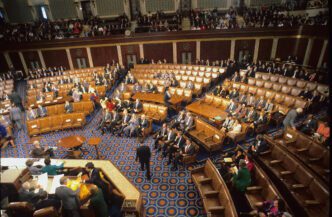Executive Summary
The Story So Far
Why This Matters
Who Thinks What?
The House of Representatives, led by Speaker Mike Johnson, passed a seven-week stopgap funding bill on Friday, aiming to avert a government shutdown ahead of the September 30 deadline. The narrow 217-212 vote sends the measure to the Senate, intensifying pressure on Democrats to either back the Republican proposal or risk a potential spending stalemate.
House Vote and Leadership Test
Friday’s vote served as a critical test of Speaker Johnson’s ability to unite his often-divided Republican conference, given his slim majority that allowed for only two defections. Republican Representatives Thomas Massie of Kentucky and Victoria Spartz of Indiana voted against the bill, while Democratic Representative Jared Golden of Maine crossed party lines to support it.
Despite the deadline being over a week away, the vote significantly increases the likelihood of a funding lapse. Both Republican and Democratic leaders are currently unwilling to compromise, and lawmakers from both chambers could potentially leave Washington for the upcoming week without a clear path forward.
GOP Strategy and Senate Pressure
In an effort to escalate pressure on Democrats, House Majority Leader Steve Scalise confirmed that GOP leaders considered recessing lawmakers through October 1 if the bill passed. This move would effectively force senators to either approve the House’s measure or allow government funding to lapse by the end-of-month deadline.
Meanwhile, Senate Democrats reached an agreement with GOP leaders to vote on competing funding bills on Friday – the Republican proposal and a Democratic counterproposal. Both measures are widely expected to fail. Senate Majority Leader John Thune indicated that he plans to reintroduce the GOP plan for another vote closer to the September 30 deadline, aiming to compel Democrats to accept it or face a prolonged shutdown.
Divergent Funding Proposals
Republicans have characterized their bill, which would fund the government through November 20, as a “clean” continuing resolution (CR). It includes minor allocations, specifically $30 million for congressional security and $58 million for security for the executive and judicial branches. The bill also incorporates a funding “fix” for Washington D.C., which would release $1 billion of the city’s own funds by correcting a previous legislative error.
In contrast, the Democratic bill includes substantial health care policy changes, such as extending enhanced Affordable Care Act subsidies set to expire at year-end. Republicans argue that these issues are inappropriate for a short-term funding bill and should instead be negotiated as part of a comprehensive year-end funding package.
However, Democratic leaders, facing pressure from their base to challenge President Donald Trump and the Republican majority, are keen to leverage this budgetary dispute to advance their policy priorities.
Outlook for Averting Shutdown
As the September 30 deadline rapidly approaches, the passage of the House GOP’s stopgap bill has intensified the standoff between the two parties. With both sides currently entrenched in their positions and competing legislative proposals on the table, the path to averting a government shutdown remains highly uncertain.








